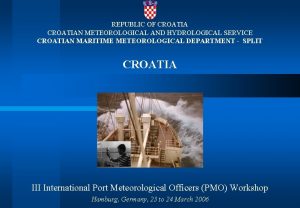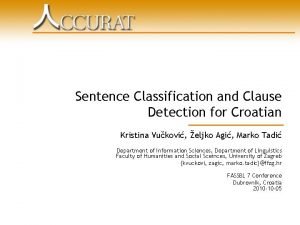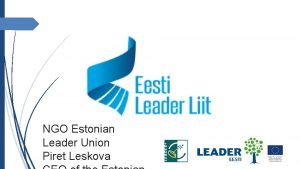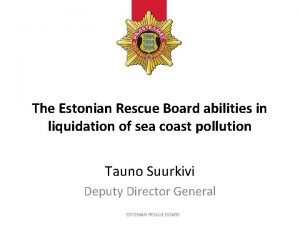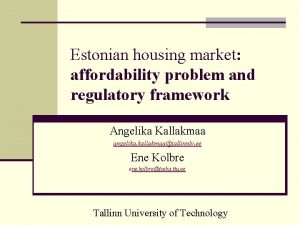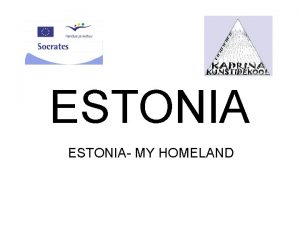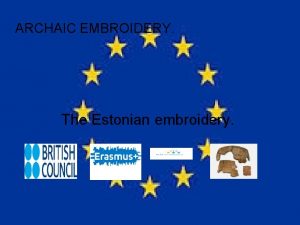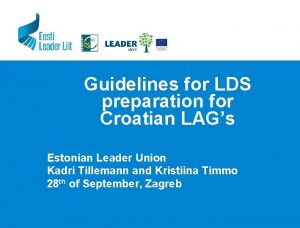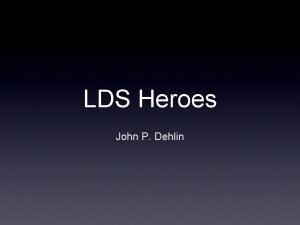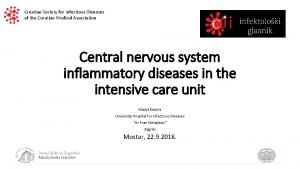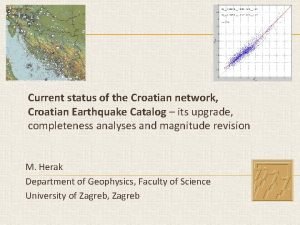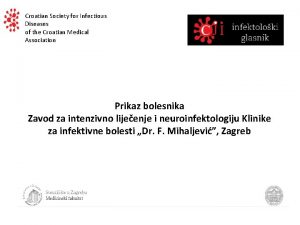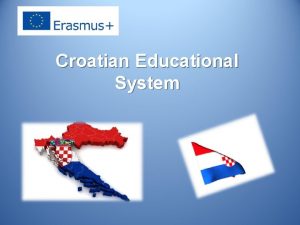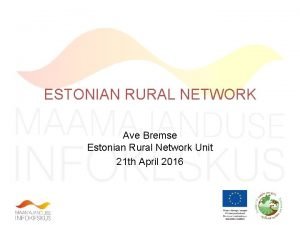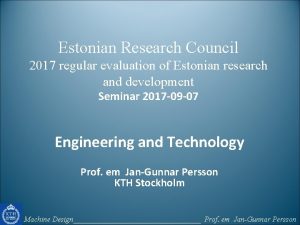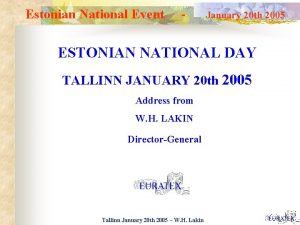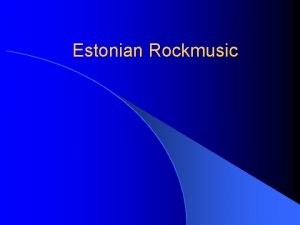Guidelines for LDS preparation for Croatian LAGs Estonian




















- Slides: 20

Guidelines for LDS preparation for Croatian LAG’s Estonian Leader Union Kadri Tillemann and Kristiina Timmo 28 th of September, Zagreb

Introduction and background - Tender by Ministry of Agriculture - An offer based on Estonian experiences, international team - Data collection, visits, meeting and web questionnaire (15 responses) in September - Outputs: (1) LDS Guide; (2) Guidance for Monitoring and Evaluations (3) Recommendations for LDS evaluation

General recommendations - LDS’s should be more focused, based on area’s own particular situation and internally and externally coherent; - success of the LDS depends on the value of individual accepted projects (continuity issue); - length and content of LDS preparation period – collection of information, internal procedures (incl. drafting LDS), stakeholder involvement, disclosure, approval

The logic of strategy VISION INDICATORS TYPES OF OPERATIONS OBJECTIVES ACTIVITIES

Different components of strategy

Mandatory content of LDS 5. 1. DESCRIPTION OF THE AREA 5. 2 ANALYSIS OF THE DEVELOPMENT NEEDS OF THE AREA, SWOT ANALYSIS 5. 3 LDS OBJECTIVES, INTEGRATED AND INNOVATIVE CHARACTERISTICS 5. 3. 1 LDS objectives and priorities 5. 3. 2 Description of activities and types of operations 5. 3. 3 Project selection 5. 3. 4 Co-operation projects 5. 3. 5 Compliance with higher-level strategic documents, integration and innovation 5. 4 STAKEHOLDER INVOLVEMENT 5. 5 ACTION PLAN 5. 6 LDS MONITORING AND EVALUATION 5. 6. 1 Evaluation plan 5. 7 LAG’S CAPACITIES TO IMPLEMENT LDS 5. 8 FINANCIAL PLAN

Recommendations of LDS content (1) Unity of the LAG area have to be justified in LDS – Why exactly this area selected to form LAG (physical or geographical coherence, cultural identity and common social, economical issues, etc)? ; Coherence of the whole LDS – How the development needs, situation analysis and SWOT are related to vision, objectives, activities, type of operations, indicators and even selection criteria? ; Objectives must be described in SMART terms – specific, measurable, achievable, realistic, time bound; Hierarchy of objectives – What kind of objectives are the most important and which activities will best contribute to achieving these? ; Focusing of the LDS – Which objectives have the biggest value for the community and achievable through LDS? There are several possibilities to focus - objectives, activities, selection criteria;

Recommendations of LDS content (2) Innovative and integrated character of LDS – What is the added value and how we can create internal cohesion of the area (involvement of different sectors, areas, linkages between target groups, thematic issues etc)? Cooperation activities description – What kind of cooperation LAG foresees to empower the development of the area? Animation and LAG projects – How LAG will contribute to the development of the area? Capability of LAG – How the implementation of LDS is organized and all important risks considered analyzed?

Recommendations of LDS content (3) Financial plan - the division of the budget between activities and types of operations is logical and in accordance with LDS objectives; other financial resources will be presented and the budget takes into account the sustainability of LAG; High level involvement of stakeholders – skilful communication, networking, trainings, study tours etc; Monitoring and specific arrangement to evaluation – How LAG assures the evaluation of all objectives?

Implementation of LDS Management and administration Processing and selection of project applications Involvement and dissemination Projects advisory LAG animation and development projects LAG inter-territorial and transnational co-operation Capability of LAG – trainings, study tours, etc Monitoring and evaluation

LDS monitoring and evaluation (1)

LDS monitoring and evaluation (1)

Main recommendations for project selection (1) Selection criteria cohesion with strategy objectives and indicators; The selection procedure and criteria must be simple, transparent and understandable for the local community; Reasonable maximum could be around eight criteria; Selection commission takes care of qualitative assessment and LAG staff validates the eligibility and technical requirements; Selection commission includes people with local knowledge and the ability to see bigger picture and understand the essence of integrated development; Conflicts of interests must be avoided; LAG will work out the documentation for procedures realted to applications.

Main recommendations for project selection (2) A suggested list for LAG regulations: 1. Regulation to organize project calls, manage consultancy, submission and processing of applications (important procedures and deadlines); 2. Regulation of selection commission formation, rules of procedures of commission and rules of removal of the commission members from selection procedures; 3. Projects selection criteria and rules how the ranking of applications will be formed; 4. Regulation to arrange necessary preservation of all the documentations related to project applications, processing and selection; 5. Guidance documentation for project applicants, f. g. rules for tenders, voluntary work diary, rules to mark objects with Leader logos etc.

? R O T Developing Leader good practice C A FRegulating T Leader more S U and more T E H R T

Electronic information system

LAG cooperation projects (19. 3) Preparation of cooperation project (meetings with potential partners, study visits, defining the cooperation areas, etc) Cooperation agreement between partners Designing cooperation project together with partners Staff and Board of the LAG prepare the project and check the accordance with LDS and list of criteria Approval of the cooperation project by LAG General Assembly Submission of the cooperation project to PA Implementation of the cooperation project Reporting to the PA and MA, collecting monitoring indicators, evaluating the results and impact of project Prosessing of the cooperation project by MA

LAG cooperation projects (19. 3) Quantitative criteria (no of partners, type of co-operation project, the role of the LAG), no of study visits to be attended/hosted by the LAG, no of international events arranged, no of joint publications to be published to disseminate the project’s results, no of target’ group’s representatives to be included into the project’s activities etc. Specific qualitative criteria - Co- operation project’s contribution into the objective (s) of the LDS - Co-operation project’s cohesion with the LDS’s - how it is interlinked with LDS’s activities, types of operations, project’s contribution to the indicators related to the type (s) of operation (s). Universal qualitative criteria - Justification of the project and it’s budget - Results of the project and their relevance sustainability - Capability of the LAG to implement this specific cooperation project (incl previous experiences) - Relevance of the partner(s) - Project contribution to the horizontal principles – innovative character of the project activities, environmental sustainability etc.

LDS evaluation 1) The description of the development potential of the LAG-area. 2) The adequacy of LDS objectives, activities and types of operations. 3) The internal cohesion of the LDS. 4) The consideration of important interventions in the LAG area. 5) Co-operation with other partnerships. 6) The financial plan of LDS. 7) The sustainability of the implementation of the LDS. 8) LDS’s contribution into RDP’s LEADER-specific objectives. 9) LDS’s contribution into EAFRD priorities. 10) The community’s involvement into the LDS preparation process. 11) The LAG’s administrative and financial capacity and experiences. 12) Description of the project support. 13) The clarity and transparency of the decision-making processes 14) LAG’s capability to perform animation activities in the area.

Thank you for your attention!
 Kalinovica 3
Kalinovica 3 Croatian meteorological and hydrological service
Croatian meteorological and hydrological service Croatian sentences
Croatian sentences Croatian forest research institute
Croatian forest research institute Hola in greek
Hola in greek Croatian national animal
Croatian national animal Croatian christmas traditions
Croatian christmas traditions Croatian sentence structure
Croatian sentence structure Estonian
Estonian Estonian real estate market
Estonian real estate market Estonia country language
Estonia country language Estonian rescue board
Estonian rescue board Estonian healthcare system
Estonian healthcare system Estonian ict cluster
Estonian ict cluster Estonian real estate market
Estonian real estate market Estonian black bread recipe
Estonian black bread recipe Estonian national bird
Estonian national bird Estonian embroidery
Estonian embroidery Estonian aviation academy
Estonian aviation academy Estonian peat cake
Estonian peat cake Traditional estonian kitchen
Traditional estonian kitchen

